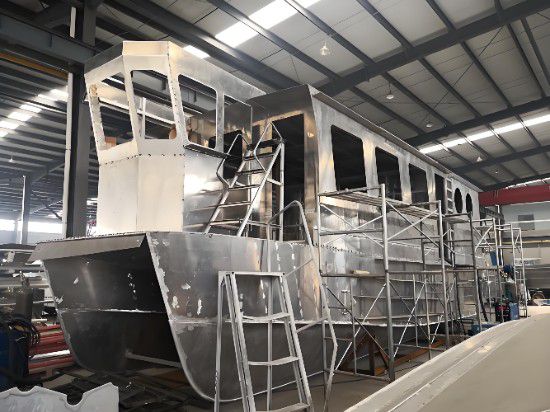Aluminum alloys for ships need to have excellent corrosion resistance, lightweight properties and sufficient strength to adapt to the marine environment and hull structure requirements, and are widely used in ship structures and components.

Commonly used aluminum alloys for ships:
1. 5000 series aluminum-magnesium alloy (Al-Mg series) - the core of corrosion resistance
- Features: 2%~5% magnesium content, low density, excellent weldability, outstanding corrosion resistance in seawater environment, especially strong resistance to electrochemical corrosion, and is the first choice for lightweight ship structures.
- Typical grades and applications:
1). 5083:
- Contains about 4.5% magnesium and is one of the most classic alloys in the ship field, with an excellent balance of strength and corrosion resistance.
- Applications: hull shell, deck, bulkhead, seawater pipeline, superstructure structure (such as passenger ship porthole frame), and even submarine pressure hull.
2). 5052:
- Contains about 2.5% magnesium, slightly lower strength but better plasticity, and corrosion resistance close to 5083.
- Application: non-load-bearing internal structures of hulls (such as bulkheads), fuel tanks, pressure vessels (resistant to seawater and fuel corrosion).
3). 5456:
- It contains a higher magnesium content (about 5%), and the addition of chromium improves stress corrosion resistance, and its strength is higher than 5083.
- Application: Welded structures that require high strength, such as keels and anchor chain locker parts of large ships.
2. 6000 series aluminum-magnesium-silicon alloy (Al-Mg-Si series) - both strength and processability
- Features: heat-treatable and strengthened, moderate strength, excellent extrusion formability, stable performance after welding, suitable for complex structural parts.
- Typical grades and applications:
1). 6082:
- The most commonly used 6000 series alumium alloy in European ship standards (such as EN standards), with higher strength than 6061 aluminum and good weldability.
- Application: hull frames, masts, deck support structures, door and window profiles (extruded parts).
2). 6061:
- More common in North America, slightly lower in strength than 6082 aluminum , but better in toughness and low in processing cost.
- Application: hull frames of small ships, yacht accessories, mechanical connectors (such as brackets).
The most common aluminum for boat building:
1. 5083 aluminum alloy - the "golden material" for hulls
- Common reasons:
- Top seawater corrosion resistance, no need for additional thick anti-corrosion layer, reducing maintenance costs;
- Good weldability, suitable for large hull segment welding assembly;
- Strength is sufficient to withstand hull water pressure and wind and wave loads, and the density is only 1/3 of steel, significantly reducing weight.
- Typical scenarios: hull shells and main load-bearing structures of civilian merchant ships, yachts, and warships.
2. 6082 aluminum alloy - the "main player" of structural parts
- Common reasons:
- Excellent extrusion formability, can be made into profiles of various complex cross-sections (such as T-shaped and U-shaped beams);
- The strength after heat treatment (about 300MPa) meets the requirements of hull frames, and the price is lower than that of 7000 series alloys;
- The performance of the welding heat-affected zone is stable, suitable for on-site construction.
- Typical scenarios: internal support frames of hulls, deck railings, and superstructure skeletons.
3. 5052 aluminum alloy - lightweight and corrosion-resistant "supporting role"
- Common reasons:
- Good plasticity, suitable for stamping or bending, low processing cost;
- The corrosion resistance is close to that of 5083, but it can be used to reduce weight in parts with low strength requirements (such as internal partitions).
- Typical scenarios: non-load-bearing hull interior panels, fuel tanks, and piping systems.
Core considerations for selecting marine grade aluminum alloys
1. Corrosion resistance priority: In seawater environments, 5000 series aluminum alloys (such as 5083) form a dense oxide film due to magnesium elements, and their corrosion resistance far exceeds that of 2000 series (Al-Cu) or 7000 series, so 5000 series is preferred for the main body of the hull.
2. Strength and weight balance: Large ships need to take into account strength, and 5083+6082 are used in combination (5083 for the shell and 6082 for the frame).
3. Processing technology adaptability: 6082 is mostly used for extruded profiles, and 5083 is preferred for welded structures.
Among marine aluminum alloys for ships, 5083, 6082, and 5052 are the most widely used grades, and they have become the core materials of hull structures by virtue of corrosion resistance, processability, and cost-effectiveness. The selection of these materials has always been based on the three principles of "marine environment adaptability, lightweight benefits, and structural reliability."